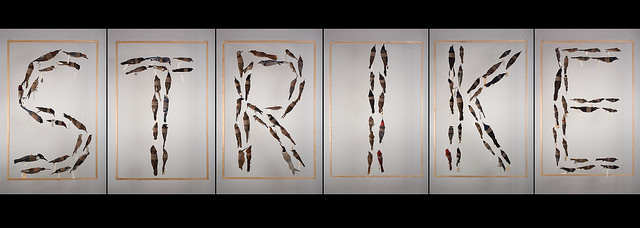
OSU students and staff participating in Biggest Week in American Birding in Northern Ohio. ©Stephanie Malinich, 2012
As a bird-watcher, spring is my favorite time of the year. Every spring millions of birds start to migrate from their wintering grounds to their summer breeding grounds. Surprising to most people, many birds migrate at night and typically you will not see large flocks of small birds traveling throughout the day. Spring migration can be a great time to see new species of birds that may not live in your state year round and this is a time for celebrating birds. But this joyous time for birders can also be an incredibly fatal time for birds that have traveled thousands of miles on their migratory pathway to their nesting grounds.
An estimated 500,000,000 bird fatalities occur in North America each year due to anthropogenic sources including collisions with building (Erickson et al 2005). Yes, this is correct, 500 million birds! This number is especially heightened by the peak migration times of spring and fall, when birds migrating at night are most likely to die: Night migrating birds have always used light to orient themselves and usually the moon and stars are the only light sources in the night sky. However nowadays brightly-lit buildings disorient these birds causing them to collide with windows in buildings. Typically, birds are trying to closely approach the light source (similar to insects around a street lamp) or circle the light source (in this case the building) until a point of complete exhaustion.

A Blue-winged Warbler collided with a downtown Columbus building. © Stephanie Malinich, 2016
This makes building collisions a top fatality to birds on their migratory pathway. Actions since this discovery have been taken to lower the numbers of building fatalities, e.g. through the national effort of Lights Out programs by the Audubon society. The overall goal of the Lights Out programs are to work with building managers in major cities to reduce the amount of light at night during peak migration season. Not only will this help reduce fatalities for nocturnally migrating birds but reduce energy costs for building owners – a win-win situation.
Many of Ohio’s major cities such as Columbus, Cleveland, Dayton, and Toledo have participated in Light’s Out Programs. Active in Ohio since 2012, researchers have worked with managers of some familiar buildings such as the AEP corporate headquarters, Columbia Gas, Columbus City Hall, Grange Insurance Audubon Center, and more on reducing lights at nights during peak migration seasons. Are you curious about Columbus’s impact on bird building collisions? Columbus Lights Out monitoring report from 2012-2013 gives insights into how lights on buildings in Columbus are affecting the amount of collision death and injury in birds.

Blackburnian Warbler collected by Lights Out Columbus volunteers for a study of building collisions. ©Lights Out Columbus, 2013
What do programs such as Lights Out, which survey injured and dead birds, mean for museum collections around these major cities? For Columbus it meant that birds found dead were submitted to the Museum of Biological Diversity’s Tetrapod Collection, where they are now used as tools in teaching students and making them aware of the impact buildings can have on bird populations. In the two years when we collaborated with the Columbus Lights Out program we received over 200 bird specimens which had died from building collisions in downtown. These now remain as vouchered specimens in our collection, as physical proof, as well as scientific tool, on the impact that building collections have during migration season.
Overall as collection manager, I see a huge increase in our bird salvage intake during spring. This is primarily due to citizen scientists who find birds that have struck windows on their house, work buildings, etc., and want to make sure the birds death was not in vain. On average the Tetrapod collection receives close to 100 bird specimens with suspected death from building collision each year. This April and May alone, I have already received 15 bird species that have died from impacts with windows or buildings and spring migration is not yet close to completion. If you find a dead bird and do not know what do with it, please visit the museum’s Contribute Specimens webpage to learn about how to donate a specimen to the Tetrapod Collection. Are you worried that your home may be adding to building fatalities among birds? The Lights Out program has suggestions on how you can stop bird collisions at your home or feel free to contact us for some suggestions.
Are you curious to find out more about what can be done to make others aware of window or building collisions by birds during spring migration? See pictures of what Ohio State University’s BioPresence project has done to raise awareness in their art exhibition last fall.
About the Author: Stephanie Malinich is Collection Manager of the OSU Tetrapod Collection.
Reference: Erickson, Wallace P.; Johnson, Gregory D.; Young, David P. Jr. (2005). “A summary and comparison of bird mortality from anthropogenic causes with an emphasis on collisions.” In: Ralph, C. John; Rich, Terrell D., editors 2005. Bird Conservation Implementation and Integration in the Americas: Proceedings of the Third International Partners in Flight Conference. 2002 March 20-24; Asilomar, California, Volume 2 Gen. Tech. Rep. PSW-GTR-191. Albany, CA: U.S. Dept. of Agriculture, Forest Service, Pacific Southwest Research Station: p. 1029-1042










